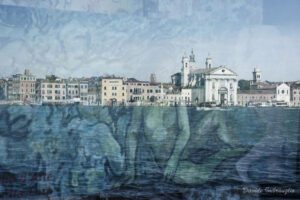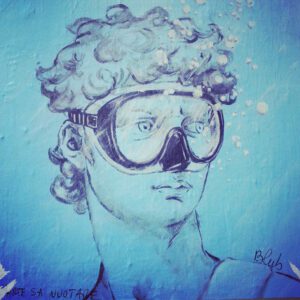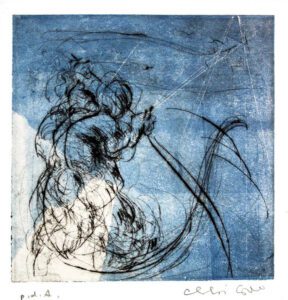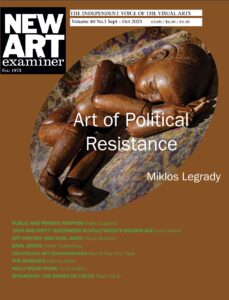
Blub: David Underwater
by Liviana Martin

I spent a weekend in Venice after the lockdown to rediscover art galleries and artists’ studios that are finally reopening, or are under refurbishment. I visited the historic and prestigious Contini Gallery; founded by Stefano Contini in 1979, it has three offices in Venice and one in Cortina d’Ampezzo.
Over the phone the gallery owner tells me that the gallery represents artists such as Igor Mitoraj, Manolo Valdes, Julio Larraz, Pablo Atchugarry, Robert Indiana, and Fernando Botero. He emphasised that his role is not that of a shopkeeper who buys and sells; he chooses artists on the basis of his own taste, not simple market needs, and works together with them to create a life path. Contini cites the memoirs of the art dealer who sold Matisse’s, Chagall’s and Picasso’s works: “The paintings I sold made me live well, those I didn’t sell enriched me.”
The gallery also promotes the works of Italian artists such as Enzo Fiore (whose technique mixes resin, earth, leaves, roots and insects in his works) and Carla Tolomeo (who creates armchairs with velvets, silk and gold, and crystals).
The wealthy clientele is well informed about valuations and prices. Collectors, says Contini, are like gamblers: they cannot do without art, so this sector is the one that has been least affected by the economic disaster following the lockdown. The gallery really thrives on relationships, travelling to make the works known, and exhibitions, with several every year, even if today 10% of the sales take place via the Internet.
I enter the largest space in the gallery, which is spread over three floors; spaces of pure beauty. The large sculptures by the Polish artist Igor Mitoraj (1934-2014) in bronze and marble are inspired by classicism, but the bodies and faces are fragmented, blindfolded, mutilated, bearing the signs of the ravages of time.
Manolo Valdes (born 1942 in Valencia, Spain) is an eclectic artist influenced by Velasquez, Rembrandt and Picasso among others. Above all, I am impressed by La Menina, a marble sculpture based on the famous work by Velasquez.

Pablo Atchugarry (1954, Montevideo, Uruguay) fascinates me with his sculptures in white marble or bronze painted in bright colors – pure abstract shapes, intertwining lines, and volumes that develop in an unexpected way in his search for perfection.
Art knows how to swim
I leave the centre of Venice and board the vaporetto that takes me to Giudecca, one of the many islands on which the city stands, less affected by tourism and inhabited by Venetians for generations.
In a building from the 1500s I meet Rosalba Giorcelli, who founded the Giudecca 795 Art Gallery in 2007 to promote emerging artists, focusing on new trends in painting, sculpture and photography. Hers is the first (and for the moment the only) gallery in Venice to host and launch street art. During the 2019 Biennale she invited a group of artists who by day produced original pieces for the gallery and by night scattered their works around the city, favouring abandoned places. Each artist expressed a style and a personal message, but what united them was the idea of an art that can be appreciated by everyone.
Blub, a Florentine street artist, used electricity company counters for his series ‘Art knows how to swim’. With a particular technique he reproduced various protagonists from works of art (the Mona Lisa, Lady with an Ermine, Girl with a Pearl Earring) wearing a diving mask, immersed in a watery background. Blub says: “Water is my element … For this reason I promote characters who have transmitted an example of greatness that still lives on today … that are timeless”.
The artists want to remain unknown (like Banksy), their work speaks for each of them.
Another interesting artist promoted by the gallery is Francesco Sabbatucci, who studied with William Congdon but for a long time devoted himself to other activities. When he returned to painting, he produced works that relate to the space, volumes and colours of Venice.
The gallery also promotes an International Photography Contest, to which amateur and professional photographers from all over the world are invited to participate with images that have Venice as their theme.
Painting with emotions

Close by, attracted by the bright colours of the canvases on display, I enter the studio of Claudia Corò, a young but already successful figurative artist, who became a mother during the lockdown. Her paintings depict the Lagoon and the city of Venice; water and music are the protagonists. Despite the classical references, Claudia constantly experiments: her ‘False visions’ were born from music and darkness. While a violinist played Bach or a jazz player his saxophone, Claudia painted in the dark, guided by the emotions aroused by the notes. The results are improvisations full of colour, vitality, originality.
Her ‘Venetian maps’ are another testimony to her originality. Claudia says that living in a magical place like Venice, where anyone can get lost in the labyrinth of alleys and dead-end streets, has amplified her imagination. Thus, on maps of real environments, she superimposes figures of fishermen, nets, gondolas and squeri (small shipyards where the lagoon boats are built).
As the critics said about her work, there is something more than what the eye can see, there is the mystery of underlying things.
Volume 35 no. 1 September / October 2020


Frankly, reading this review hurt! It hurt because all that Venice has to offer us is locked up in our lockdowns. I feel nostalgia, I feel homesick and sad at the prospect of not being able to travel freely to Venice whenever I want. Apart from the financial aspect of the high cost of travel, the thought of not being able to go to this unique city of art represents real pain for me and my dreams that have been crushed, thanks to this miserable virus.
But you can visit Venice, and everywhere. Online shows abounding have allowed us to travel the world to see museum and gallery shows without spending on airfare or lodging. It’s not ideal as you cannot experience the size and majesty of the art, but it is accessible.
No way can I find virtual travel “to see museum and gallery shows” stimulating or satisfying. I think we all, or most of us, have had enough of virtual living. Artworks need to be seen in person; just as our world treasures need to be seen in person and not online.
virtual is not even close, the smells, the colors, the light!!!
Jose captures my thoughts exactly.